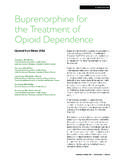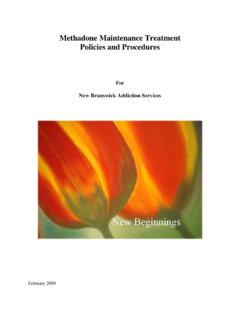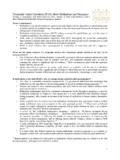Transcription of Systematic review of the safety of buprenorphine ...
1 Systematic review of the safety of buprenorphine , methadone and naltrexone Dr Andy Gray Department of Therapeutics and Medicines Center for the AIDS Programme of Research in South Africa Congella, South Africa BACKGROUND DOCUMENT PREPARED FOR THIRD MEETING OF TECHNICAL DEVELOPMENT GROUP (TDG) FOR THE WHO "GUIDELINES FOR PSYCHOSOCIALLY ASSISTED PHARMACOTHERAPY OF OPIOID DEPENDENCE" 17-21 SEPTEMBER 2007 GENEVA, SWITZERLAND TABLE OF CONTENTS Systematic review OF THE safety OF buprenorphine , methadone AND NALTREXONE 1 1 TERMS OF REFERENCE 3 2 buprenorphine 4 INTRODUCTION 4 SEARCH STRATEGY 5 RESULTS 5 Evidence from Cochrane Reviews 5 Evidence from recent controlled trials 9 Evidence from other sources 11 Evidence from spontaneous ADR reports 12 Summary 14 3 methadone 15 INTRODUCTION 15 SEARCH STRATEGY 16 RESULTS 17 Evidence from Cochrane Reviews 17 Evidence from recent controlled trials 18 Evidence from other sources 19 The issue of cardiotoxicity 21 The issue of dental caries 23 Evidence from spontaneous ADR reports 24 Summary 25 4 NALTREXONE 26 INTRODUCTION 26 SEARCH STRATEGY 28 RESULTS 28 Evidence from Cochrane Reviews 28
2 Evidence from recent controlled trials 30 Evidence from other sources 30 Evidence from spontaneous ADR reports 31 Summary 31 5 SUMMARY TABLE AND CONCLUSIONS 32 6 ACKNOWLEDGEMENTS 33 7 REFERENCES 34 1 Terms of reference The terms of reference of this consultancy were to: 1. perform a comprehensive review of safety of buprenorphine , methadone and naltrexone in the treatment of opioid dependence, including Systematic literature search (limited to English language only) and analysis of database(s) and other information sources provided by WHO, in consultation with International Drug Monitoring Centre. 2. To perform meta-analysis of the data available, if appropriate. 3. To submit a draft of the review to WHO as an electronic copy.
3 4. To submit an electronic database of identified references. 5. To incorporate comments provided by WHO into the final draft and submit revised products to WHO. This safety assessment forms part of the input process for the Technical Guideline Development Group for Treatment of Opioid Dependence. The consultant was also provided with the following documents from that process: Report on the 1st Consultation on Technical Guidelines for Treatment of Opioid Dependence WHO Guidelines for psychosocially assisted pharmacological treatment of persons dependent on opioids, prepared as a background paper for the above meeting by Uchtenhagen et al. An overview of Cochrane Systematic reviews of pharmacological and psychosocial treatment of opioid dependence, prepared as a background paper for the above meeting by Amato et al.
4 Overview of Non Cochrane Systematic reviews of pharmacological and psychosocial treatment of opioid dependence, prepared as a background paper for the above meeting by Minozzi et al. A first draft report was thus directed at ToRs 1 to 3. The document seeks to complement the work already done in the background papers to the 1st Consultation, rather than to repeat work already done. An electronic database of the references cited, in the form of an Endnote v9 file, is attached, together with .rtf files of the listing of the references cited as well as the composite sets of literature retrieved for all 3 agents. This final report takes into account requests for a summary table and conclusions section, as well as additional attention to the problems of dental caries in methadone users.
5 The methods followed and the results of the Systematic review are presented for each of the 3 drugs in the order stated. 2 buprenorphine Introduction buprenorphine is an opioid partial agonist/antagonist. It has high affinity but low intrinsic activity at the (mu) receptor. It is also capable of binding at the (kappa) receptor. The rate of dissociation from the receptors is slow, which results in an antagonistic effect to any other opioids that may be co-administered. In addition, buprenorphine exhibits a ceiling effect, in that higher doses do not produce additional effects in terms of both positive mood and respiratory depression. It would therefore be expected that buprenorphine would be well tolerated and relatively safer than the full agonists, such as methadone .
6 When taken orally, buprenorphine undergoes first-pass hepatic metabolism with N-dealkylation and glucuroconjugation in the small intestine. The use of the sublingual route is therefore appropriate. After sublingual administration, peak plasma concentrations are achieved in 90 minutes. A linear dose-concentration relationship is evident between 2 mg and 16 mg. Distribution is rapid and the half-life is 2 to 5 hours. buprenorphine is oxidatively metabolised by cytochrome P450 CYP3A4 and by glucuroconjugation of the parent molecule and the dealkylated metabolite (norbuprenorphine). It has a long terminal elimination phase of 20 to 25 hours, due in part to reabsorption of buprenorphine after intestinal hydrolysis of the conjugated derivative, and in part to the highly lipophilic nature of the molecule.
7 The conjugated metabolites are excreted mostly in the faeces by biliary excretion (80%), but also in the urine. Standard drug monographs provide the following as the expected adverse effects for buprenorphine : constipation headaches insomnia asthenia drowsiness nausea and vomiting fainting and dizziness orthostatic hypotension sweating More rarely, the following have been noted: respiratory depression hepatic necrosis and hepatitis hallucinations bronchospasm angioneurotic oedema anaphylactic shock In cases where the substance is misused by intravenous injection, local reactions, sepsis and hepatitis have been reported. As is expected from the partial agonist mechanism of action and the slow dissociation from these receptors, patients with marked opioid dependence may experience withdrawal effects when administered buprenorphine .
8 Conversely, abrupt cessation of buprenorphine administration can result in a slower onset of withdrawal symptoms and a less pronounced withdrawal syndrome in patients chronically dosed with this drug. The expected manifestations of acute overdose would include pinpoint pupils, sedation, hypotension, respiratory depression and death. Search strategy buprenorphine has been the subject of two Cochrane Reviews(Mattick, Kimber et al. 2003; Gowing, Ali et al. 2006), and these were used as the basis for the search strategy. Details of safety data considered in the Cochrane Reviews were gathered, where possible from the original references included in the reviews. More recent randomised controlled trials (RCTs) and controlled trials (CTs) in the management of opioid dependence, published after the Cochrane Reviews, were obtained by searching Medline and the Cochrane CENTRAL database.
9 The PubMed Clinical Query utility was employed, using the following search strategy: ( buprenorphine ) AND ((clinical[Title/Abstract] AND trial[Title/Abstract]) OR clinical trials[MeSH Terms] OR clinical trial[Publication Type] OR random*[Title/Abstract] OR random allocation[MeSH Terms] OR therapeutic use[MeSH Subheading]) The bibliographies of such references were also hand searched for any additional sources. A broad, sensitive search of Medline was also conducted using the following strategies: " buprenorphine "[MeSH] AND "adverse effects"[Subheading] " buprenorphine "[MeSH] AND "Drug Toxicity"[MeSH] " buprenorphine "[MeSH] AND "toxicity"[Subheading] " buprenorphine "[MeSH] AND "Overdose"[MeSH] The results of these searches are provided as additional Endnote Libraries, combined and with duplicates removed.
10 This strategy was used to identify additional reviews, observational studies and programmatic reports, case series and significant case reports. The evidence is presented from each of the categories identified above: Evidence from Cochrane reviews Evidence from randomised controlled trials and controlled trials published after the Cochrane Reviews Evidence from other sources (observational studies and programmatic reports, case series and significant case reports) Lastly, data from the Uppsala Monitoring Centre are presented, representing spontaneous adverse event reports from member countries. Results Evidence from Cochrane Reviews Mattick, Kimber et al (2003) reviewed RCTs of buprenorphine maintenance therapy versus either placebo or methadone for opioid dependence.
















